 Kawasaki Z400 - Service manual > Switches and Sensors
Kawasaki Z400 - Service manual > Switches and Sensors
Brake Light Tuning Inspection
- Refer to the Brake Light Switch Operation Inspection in the Periodic Maintenance chapter.
Brake Light Timing Adjustment
- Refer to the Brake Light Switch Operation Inspection in the Periodic Maintenance chapter.
Switch Inspection
- Using a digital meter, check to see that only the connections shown in the table have continuity.
For the switch housings and the ignition switch, refer to the tables in the Wiring Diagram.
*If the switch has an open or short, repair it or replace it with a new one.
Rear Brake Light Switch Connections

Side Stand Switch Connections 
Oil Pressure Switch Connections*

*: Engine lubrication system is in good condition.
Water Temperature Sensor Inspection

- Remove the water temperature sensor (see Water Temperature Sensor Removal/Installation in the Fuel System (DFI) chapter).
- Suspend the sensor [A] in a container of coolant so that the temperature-sensing projection is submerged.
- Suspend an accurate thermometer [B] with temperature -sensing projection [C] located in almost the same depth with the sensor.
NOTE
The sensor and thermometer must not touch the container side or bottom.
- Place the container over a source of heat and gradually raise the temperature of the coolant while stirring the coolant gently.
- Using a digital meter, measure the internal resistance of the sensor.
*If the digital meter does not show the specified values, replace the sensor
Water Temperature 8wmr Resistance

*: Reference Information
Oxygen Sensor Removal
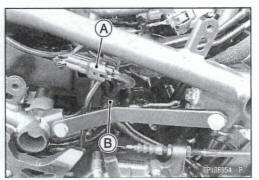
NOTICE
- Never drop the sensor especially on a hard surface.
Such a shock to the sensor can damage it.
- Do not pull strongly, twist, or bend the oxygen sensor lead. This may cause the wiring open.
- Remove: Right Middle Fairing (see Middle Fairing Removal in the Frame chapter)
- Disconnect the oxygen sensor lead connector [A].
- Open the damp [B].
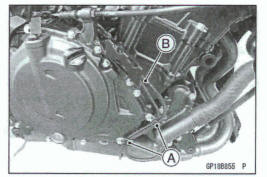
- Open the clamps [A]
- Clear the lead [B]
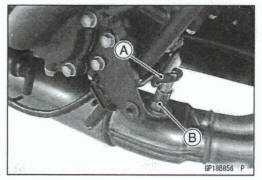
- Clear the lead [A]
- Remove the oxygen sensor [B]
Oxygen Sensor Installation
NOTICE
Never drop the oxygen sensor [A] especially on a hard surface. Such a shock to the unit can damage it. Do not touch the sensing part [B] and filter holes [C] of the sensor to prevent oil contact. Oil contamination from hands can reduce sensor performance.
- Tighten:
Torque- Oxygen Sensor: 25 N*m (2.5 kgf*m, 18 ft* lb)
- Run the oxygen sensor lead correctly (see Cable, Wire, and Hose Routing section in the Appendix chapter)
- Install the removed parts (see appropriate chapters)
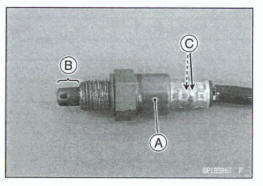
Oxygen Sensor Inspection
- Refer to the Oxygen Sensor Inspection in the Fuel System (DFI) chapter
Fuel Level Sensor Inspection
- Remove: Fuel Pump (see Fuel Pump Removal in the Fuel System (DFI) chapter)
- Check that the float moves up and down smoothly without binding. It should go down under its own weight
*If the float does not move smoothly, replace the fuel Float in Full Position [A] Float in Empty Position [B]
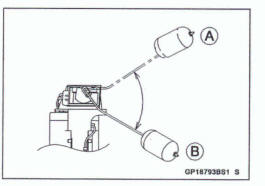
- Using a digital meter [A], measure the resistance between the R/BK lead and BK/W lead [C] terminals.

*If the digital meter readings are not as specified ,or do not change smoothly according as the float mow up and down, replace the fuel pump.
Fuel Level Sensor Resistance
Standard: Full Position: 9 ~ 11

Empty Position: 213~219

Gear Position Sensor Removal
- Remove: Battery Case Cover (see Battery Case Cover Removal in the Frame chapter)
- Disconnect the gear position sensor lead connector [A].
- Clear the lead [B].

- Clear the gear position sensor lead [A].
- Remove: Gear Position Sensor Bolt [B] and Washer Gear Position Sensor [C]
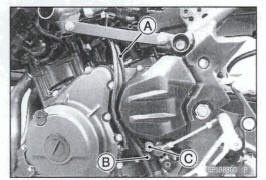
Gear Position Sensor Installation
- Replace the O-ring [A] with a new one.
- Apply grease to the new O-ring and install it.
- Face the pin [B] to the bolt hole side [C].
- Make sure that the transmission is shift into the neutral.
- Fit the pin of the gear position sensor to the groove [D] of the shift drum.
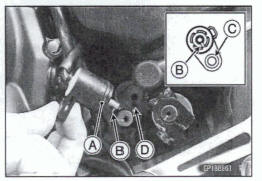
- Tighten the gear position sensor bolt with washer.
When installing the sensor which is fastened by bolt, tighten the bolt after placing the sensor on the bottom surface completely.
Toque - Gear Position Sensor Bolt: 9.8 N-m (1.0 kgf*m, 87 in*lb)
- Run the lead correctly (see Cable, Wire, and Hose Routing section in the Appendix chapter).
- Install the removed parts (see appropriate chapters).
Accessory Socket Removal/Installation (Equipped Models)
- Remove: Upper Inner Fairing (see Upper Inner Fairing Removal in the Frame chapter) Accessory Wet Nut [A] Accessory Socket [B]

- Installation is the reverse of removal
- Insert the accessory socket [A] to the upper inner fairing.
Align the tab [B] with the cut-out [C].
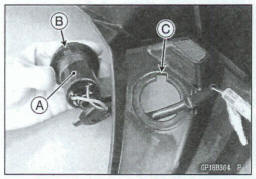
- Tighten: Torque -Accessory Socket Nut: 2.8 N-m (0.29 kgf*m, 25 in*)
- Install the removed parts (see appropriate chapters).
Accessory Relay Inspection (Equipped Models)
- Remove: Left Middle Fairing (see Middle Fairing Removal in the Frame chapter)
- Remove the accessory relay [A].
- Disconnect the accessory relay connector [B].
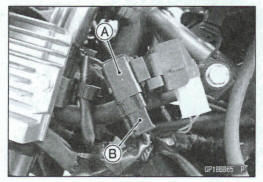
- Connect a digital meter [A] between the relay terminals [3] and [4].
- Connect a 12 V battery [B] between the relay terminals [1] and [2]
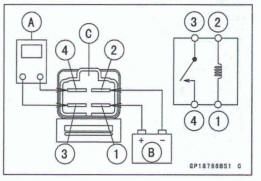
*If the relay [C] does not work as specified, the relay is defective. Replace the relay.
Testing Relay
Criteria:
When battery is connected →

When battery is disconnected →

See also:
 Kawasaki Z400 - Service manual > Meter, Gauge, Indicator Unit
Kawasaki Z400 - Service manual > Meter, Gauge, Indicator Unit
Meter Unit Removal Remove: Headlight (LED) Assembly (see Headlight (LED) Assembly Removal/Installation) Vehicle-down Sensor [A] (see Vehicle-down Sensor Removal in the Fuel System (DFI) chapter) Meter Mounting Screws [B] Pull up the meter unit [A]. Slide the dust cover [B], and disconnect the meter connector [C].
 Kawasaki Z400 - Service manual > Relay Box
Kawasaki Z400 - Service manual > Relay Box
NOTE The relay box [A] has relays and diodes. The relays and diodes can not be removed.

 Benelli Imperiale 400
Benelli Imperiale 400 BMW F900XR
BMW F900XR Honda CB500X
Honda CB500X KTM 390 Adventure
KTM 390 Adventure Triumph Street Triple S
Triumph Street Triple S Yamaha MT-03
Yamaha MT-03 Kawasaki Z400
Kawasaki Z400 Triumph Street Triple S
Triumph Street Triple S Yamaha MT-03
Yamaha MT-03